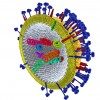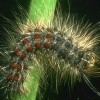G2C Online

A Microtubule Model for Memory
Mar 20th
“Neurons that fire together, wire together.” This adage is a helpful reminder to students who take a course on memory and the brain. This rhyme captures our understanding that neurons have a self-reinforcing capability that links them, and that this capacity has some relation with how memory in the brain works. It makes sense that if the same groups of neurons are involved in processing some stimulus, strong and stable connections rather than weak and transient would be preferable. We use similar optimizations when we place people on a speed-dial list, bookmark a website, or create a playlist of songs.
In More >

Just a Cluck Away from E. coli
Mar 5th
1 day-old chick
When people hear the name E. coli, even a passing familiarity brings about reactions of disgust and fear of food poisoning. This outright hatred of the common bacteria is, perhaps, a bit unwarranted, considering there are many different types of Escherichia coli. Not only are there harmful strains, but there are also many that are harmless to humans and some that are even helpful as well. We actually have our own E. coli that live in our intestines, take some of our nutrients and make essential vitamin K2 for us, which we cannot make for ourselves. Vitamin K is More >
Update Catching the Flu: Between Complacency and Fear
Feb 29th
A model of the influenza virus. (Artwork by Holger Guggi, copyright by Reingard Grabherr and Florian Krammer.)
Back in January, I blogged about how in December of 2011 the U.S. National Science Advisory Board for Biosecurity (NSABB) took the controversial step of requesting that the high-impact journals Science and Nature remove certain methodological details and the identity of the key mutations from the results to be published of two H5N1 avian influenza virus studies. The reason for this drastic regulation? The NSABB classified their results as “dual use” research – research that could be used for either beneficial or ill-purposed applications. They raised concerns about the More >

The Couch Potato Gene
Feb 23rd
Next to the rarely true excuse, “Of course I´m not too heavy… I just have heavy bones,” the couch potato gene could be the perfect excuse for those who find exercise something of a chore. It may not be an attitude problem: ‘I’m not lazy, it’s my genes!’
In investigating couch potatoes scientists have discovered why some of us have fun working out for hours while others lack energy and can barely summon the get-up-and-go to reach for the TV remote.
They believe they have identified the genes that produce an enzyme in our muscles during work outs called AMP kinase More >
New Hope for Alzheimer’s Sufferers
Feb 13th
This article in science is good news for suffers of Alzheimer’s. A group out of Case Western University reports that the drug Bexarotene can reverse the symptoms of Alzheimer’s in mouse models of the disease.
More importantly, Bexarotene is already in use in human patients, making it easier to determine if the drug will have similar benefits for Alzheimer’s patients.
According to Alzheimer’s Foundation statistics, 5.4 million Americans suffer from this debilitating disease. Alzheimer’s devastates patient’s cognitive abilities, with the most notable symptom being profound and worsening memory loss. While some amount of memory loss is to be expected with old age, Alzheimer’s patients More >

Catching the Flu: Between Complacency and Fear
Jan 25th
It is “flu season” again and people are being vaccinated against the seasonal flu. But how do these vaccines work and why do we have to get a new one every year?
And how does this relate to the issue of scientific publishing and biosecurity? Read on…
Flu – or influenza – is a serious respiratory illness (not to be confused with common cold) caused by the influenza A and B viruses. Influenza claims a death toll of about 250,000 to 500,000 people worldwide every year. Medical advances have helped understand and combat one of history’s worst killers. From 1918 to 2012 More >

How a Virus Creates Zombie Insects
Jan 4th
Photograph courtesy of the USDA Forest Service via Wikimedia Commons.
Kelli Hoover and her research team from the Penn State have found out how a virus can change the behavior of a host organism. The result is destructive for the gypsy moth but excellent for the virus.
Gypsy moths are an invasive species. In its larval stage caterpillars damage roughly a million acres of forest in the U.S. each year by feeding on tree leaves. But the damage would be greater if it weren’t for a pathogen called baculovirus that infects these caterpillars and causes them effectively to engage in suicidal More >

Compulsive Hoarding
Nov 10th
Many of us have seen the variety of shows lately on TV that highlight a behavior known as compulsive hoarding. Shows like “Hoarders” and “Hoarding: Buried Alive” give insight into the severity of this condition. On the shows, there is a person living in conditions that are, in no other words, unlivable. Things such as newspapers, magazines, clothes, boxes, knick-knacks, and food are piled in every available space in the home making walking through the home hazardous.
So what exactly is this condition that is being portrayed on these TV shows? Compulsive Hoarding is an anxiety disorder that affects as many More >

Autumn Leaves
Oct 28th
Autumn is my favorite season. I enjoy the cool weather, unpacking my sweaters from the attic and sleeping under my cozy comforter. But better than all of the above are the fantastic red, yellow and orange leaves that adorn the deciduous trees here in New York. Before I worked at the DNA Learning Center, this process was simply a beautiful rite of fall. Now, I see the whole process in a different light. It’s an elegant series of genetic steps that evolved millions of years ago, for a reason much bigger than beauty!
For most of the year, deciduous trees are More >

Origin of ALS discovered
Oct 24th
ALS (amyotrophic lateral schlerosis, a.k.a. Lou Gehrig’s disease) is a devastating disease which kills motor neurons, leaving patients paralyzed and unable to function. Although patients remain aware and for the most part mentally undamaged, most patients die within 2-3 of onset as the disease progressively leaves them trapped in a body that is unable to function. As motor neurons die, the person’s muscles weaken and atrophy, and patients will eventually develop respiratory difficulties leading to death.
Unfortunately very little is known about how this disease develops, so a new breakthrough published in Neuron (and by a second group also in Neuron) is More >
